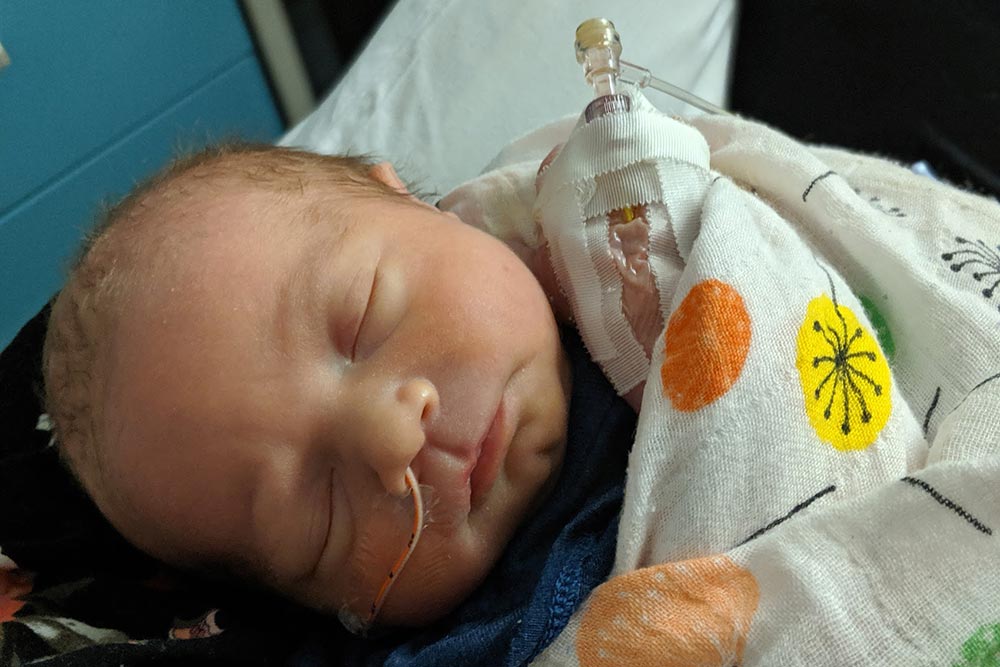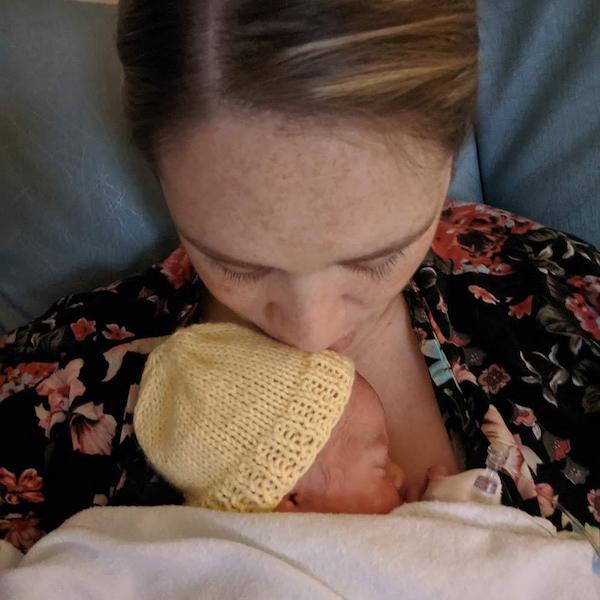NICU Awareness Month: Indy’s Birth Story

Every September, I am reminded of the strength of my family and my little NICU baby.
In June of 2019, at 33 weeks and 2 days pregnant, my water broke. Despite giving myself painful shots of progesterone for 15 weeks, it seemed my second born was determined to follow in her big sister’s footsteps with an early arrival into the world. But even though I had been through preterm labor and delivery before, nothing could prepare me for Indy’s birth and her subsequent stay in the neonatal intensive care unit (NICU).
September is NICU Awareness Month, a bittersweet time for me. On the one hand, it reminds me to appreciate the little fighter that is my youngest daughter, the amazing staff of nurses and doctors who kept her safe and healthy during her stay, and my family’s incredible support. On the other hand, it brings to the surface a weight that continues to live in my heart three years later—and the painful memories that created it in the first place.
A Second Pre-Term Baby
With my first daughter, Eva, my water broke at 34 weeks and 5 days. However, it didn’t trigger labor, so I had to be induced and she arrived at 35 weeks exactly. She was perfectly healthy and, to everyone’s surprise, she didn’t require a stay in the NICU and was able to come home from the hospital with me.
So when my water broke early with my second daughter, Indy, I wasn’t surprised or panicked. I calmly called my husband to tell him to come home from work, threw some comfy clothes into our suitcase—which was mostly packed already, in preparation—and we eventually made our way to labor and delivery. I felt confident things would go just as smoothly as they did the last time.
Unbeknownst to me, there is a big difference between delivering a preemie at 35 weeks and 33 weeks. I expected to show up at the hospital and be hooked up to an IV with antibiotics and Pitocin to get the show on the road like with my first birth. Instead, I was hooked up to antibiotics and admitted to the maternity floor, where I’d stay on bedrest until I reached at least 34 weeks unless my body went into labor on its own.
On the surface, five days of laying in bed, reading books, and watching Netflix without having to sign in to work might sound kind of nice, but it was anything but relaxing. I was experiencing prodromal contractions, which are as painful and consistent as labor contractions, but without actually advancing labor. Because of this, I underwent regular cervical checks, was hooked up to 24/7 monitoring, and was in a lot of pain that even morphine wasn’t strong enough to aid. It was horrible, so when my doctor gave me the option to be induced at 34 weeks with the caveat that the OB-GYN on call was from another practice, I didn’t care. I jumped at the opportunity.
17 Hours of Labor
After being induced, it was everyone’s expectation that things would go quickly, given this was my second baby. Unfortunately, that wasn’t the case. Indy, apparently, was in no real rush to make her grand entrance. Meanwhile, though I was comfortable with an epidural, there were some complications.
Much to my disappointment, I was put off by the on-call doctor’s (lack of) bedside manner almost immediately upon meeting her. She was dismissive and had a straightforward, no sugar-coating style—and I’m the kind of patient that needs to be babied a little bit. I quickly regretted my decision to induce early, because if I had waited another day I’d be working with the same doctor who had so wonderfully delivered Eva. There was no going back, though, so I tried to make the best of the situation. But when she incorrectly inserted an intrauterine monitor, perforated my placenta, and failed to adequately communicate with me what was going on, any trust I had in her was broken. I was terrified, in shock, and felt like the only person in that room who was looking out for me and Indy was my husband.
Several hours later, around 2:15 a.m., Indy finally started making her way out. The NICU team was in the delivery room, ready to take her vitals and decide the next steps. At this point, I was still optimistic that she’d come out as healthy as her big sister had, but after pushing for 15 minutes, I heard the doctor say, “sorry dad, you can’t cut the cord,” and realized it was wrapped around my baby girl’s neck, and I knew our experience wouldn’t be the same.

The NICU
The NICU team was swift. Once the doctor freed Indy from her cord, they whisked her to their mobile station and got her stabilized. They wrapped her in a blanket, carried her over to me, and pressed our cheeks together for a brief second before rushing her out of the room with my husband trailing behind. I was left alone with a doctor I didn’t trust and about a thousand “what-ifs” running through my brain.
Eventually, I was wheeled to recovery where I expected them to get me situated before taking me to see my baby. Once again, my expectations were wrong. As my husband slept, I sat there waiting for updates. It was four excruciating hours before I was able to officially meet my daughter.
When I was finally taken to the NICU, Indy was lying in an incubator, sedated, hooked up to a ventilator, and had wires and cords attached to her body. I wasn’t allowed to hold her. I could only put my hands in the little case and gently hold her tiny fingers. My husband rubbed my back, reassuring me as I cried, apologizing to Indy and berating my body for failing her. None of this had gone as I had expected.
I finally agreed to get some sleep, and at around 3 p.m., miraculously, Indy was strong enough to be taken off the ventilator—which meant I was finally allowed to hold her. We had my parents bring Eva to the NICU so she could be there to meet her sister. The joy on Eva’s face combined with my relief for Indy’s health was enough to return my optimism.
I spent as much time with Indy in the NICU as I could during my hospital stay, and I fell apart when I was discharged from the hospital with empty arms, having to leave my baby behind. I lasted two hours at home before calling the NICU to see how she was doing, and I raced back to the hospital early the next morning to spend the day with her before repeating the same cycle in the days that followed.
Indy was admitted to the NICU on a Monday, and by Thursday she was doing so well that the doctors told us to expect to bring her home on Friday. We were elated. We packed her diaper bag, brought the car seat carrier, and anxiously awaited the doctor’s rounds to get the final OK to bring her home.
Unfortunately, she had lost some weight overnight, and they didn’t feel comfortable discharging her yet. As soon as the doctors left the room, my husband wrapped me in his arms and let me sob. I agreed to go home at lunchtime that day, and I finally allowed myself the opportunity to lay in my bed, cry, and grieve my birth story until Eva came home from daycare and we spent the evening snuggled in bed with popcorn and a Disney movie.
Despite how difficult the day before had been, I woke up the next morning feeling better because I had finally sat with my feelings. It was the long-awaited turning point. And when we arrived at the NICU a few hours later, we were surprised to learn that Indy was cleared for discharge—she was finally coming home.

The Aftermath
When Indy was born, my family joined a club of NICU warriors. It’s an exclusive club that no one ever wants to be a member of, but it’s full of people who understand you in a way outsiders just can’t. In the months and years following Indy’s birth, I have continued to connect with moms from all over the world, sharing our stories, our pain, and advice for coping with the trauma that comes from a NICU stay.
The sound of beeping monitors will forever take my breath away. The smell of hospital soap will always make me sick to my stomach. And I will never be able to tell Indy’s birth story without a lump in my throat and tears in my eyes. This is what it means to be a NICU family. But, we are strong today because we were so broken back then.
If you’re interested in offering support to NICU staff, infants, and families, consider dropping off your baby’s newborn-size clothing at your local NICU hospital, purchasing and donating gift cards for nearby restaurants, or making a monetary donation to the department, the March of Dimes, or NICU Awareness.








